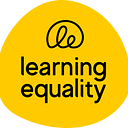Building a bridge: Reflections on co-creating semi-automated curricular tools
As we build any new solution, especially for those affected by emergency and crisis, it’s imperative that we co-design with the beneficiaries who will be impacted most by this work. We are fortunate that five incredible individuals from Kenya participated in-person in a hackathon in San Francisco, California, USA to prototype the development of a tool or set of tools to automate aspects of the curriculum alignment process. Our mutual learnings were significant, and I’m honored to have spent this time with them. Additionally, hackathon participants remarked on the usefulness of having individuals present to contextualize and ground the tools being built. In anticipation of sharing what was developed during the hackathon (and we collectively made great progress!), I am pleased to share some of the takeaways from this team from Kenya as we stood at the foot of the Golden Gate Bridge to debrief on the event, and drew analogies to the bridge in front of us.
On creating something new . . .
“For me, let me reflect using this megastructure that is in front of us. And looking at that bridge, it is made up of so many different parts, so many pieces, and it is suspended, but what keeps it from falling is what is very important for us to pay attention to. The motorists who are using that bridge might not even have been born when it was constructed. Now using that analogy, what I’ve learned from these experiences is that the technologists who are working behind the scenes to give us these programs are the small bits and pieces that come together and create the bridge that links us with the people who are not advantaged in our communities. And when I go back, I am very happy because I’ve been a part of that bridge. I can either be the cord that is holding the bridge from falling, or I could be a bolt that is used to fasten two pieces together, and I believe that the technologists have been able to benefit from my input. We are looking forward to having our users benefiting from this great project, and they could be used as an example of the motorists who are using this particular bridge — so our people, our students, our teachers, are like motorists, and they are now going to use this very beautiful bridge. For me, that is an inspiration, and I am very happy that I have played a role.” — Francis Kagutha, Kolibri Expert, Kakuma town
On seeing new solutions being created . . .
“For me, when I’m in the field, a lot of times when we’re engaged in implementation, sometimes we get solutions but you do not know how they were developed. But when we’re building a bridge, for example, you can come here and see what different parts are involved — you know, to see that in action was really illuminating for me. I go back with a lot of decisions of the fact that when you build a solution, it takes a lot of collaboration and a lot of effort. So I go back with that appreciation and the understanding that if we all work together and bring different expertise and skills that we have, we can build a solution that will support the work that we do.” — Mohamud Hure, UNHCR Education Officer, Kakuma Refugee Camp
On contributing ideas . . .
“From the perspective of the bridge, I feel I didn’t know at first that my idea and my contributions could be very important to make something stand. I think I’ve come to realize the work we do to give back to the users and also addressing the kind of challenges is also like how we can improve the bridge. It was a very good thing that we participated and hear from different solution makers to try to bring the ideas together like the bridge.” — Byaruhanga Nestori, Kolibri Expert, Kakuma Refugee Camp
On bringing ideas together . . .
“We’ve really been impressed on what it takes to build a bridge and solve a particular problem. It takes resources, it takes a lot of effort and energy, but it also takes the expertise of different people pulling together synergy to order to be able to find a solution to any sort of problem. Every one of the actors played a role, including myself. I’m so happy and proud to be a part of the team . . . I’m really impressed.” — Jayson Akilimali Mushagalusa, Kolibri Expert, Kakuma Refugee Camp
On building technology . . .
“From my perspective, knowing the difficulties that we face in education, what I am very happy about is to be part of the whole process and the effort to bring out an open source tool that is being used by everyone, that is relevant, that is incorporating some of the latest technology like machine learning, and to also have some elements of interoperability. Also, it is important to me to be able to be part of a sustained community of practice, with volunteers everywhere and a very diverse group. This is really important to me and I think to everyone else.” — Alan Mwika, UNHCR Education Officer, Dadaab Refugee Camp
This is an installment of the Design2Align blog post series to create a space for dialogue on the topics related to the development of semi-automated tools to support the curriculum alignment process.

